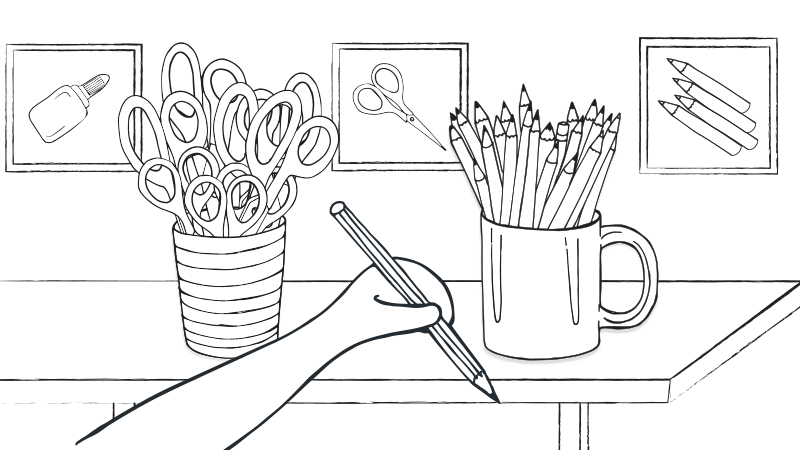Teema lühikirjeldus
Lapsed arutavad selle üle, kui tähtis on panna asjad tagasi nende õigesse kohta. Nad mõtlevad välja ideid, kuidas koristamine tõhusamaks muuta, ja teevad fotograafia abil erinevatele asjadele sildid.
Õpitulemused
-
tulemused
- Digitaal- ja meediakompetentsus
- Sotsiaaloskused: koostöö tegemine grupis
- Keeleoskused: uue sõnavara õppimine
- hooliva suhtumise kasvatamine rühmaruumis olevatesse esemetesse ja mänguasjadesse
- Peenmotoorika pädevus: pildiga siltide meisterdamine
-
Sihtgrupp
3 aastat ja rohkem- terve klass
paaristöö
rühmades
- terve klass
-
Nõutavad materjalid
- Kaamera / telefon / tahvelarvuti
- Arvuti
- Printer
- Käärid
- laminaator
- kleeplint

Laadige alla
(.pdf 345.12 KB)
Tegevuse kirjeldus (samm-sammult)
Ettevalmistus:
Koguge lapsed enda juurde ja jutustage neile mõni tore lugu kaotatud ja leitud asjadest, et äratada lastes kõnealuse teema vastu huvi. Näiteks võite rääkida loo pliiatsist, kes ei leia koduteed. Ta otsib ja otsib ning leiab lõpuks oma kodu üles tänu sildile, mis näitab, kuhu tuleb minna. Seejärel arutlege koos, miks on tähtis hoida rühmaruumi korras. Miks on oluline panna asjad tagasi nende õigesse kohta? Kuidas on asju kõige lihtsam leida? Kas teil on ideid, kuidas tuletada kõigile meelde, et asjad tuleb õigesse kohta tagasi panna? Millised peaksid olema sildid, kas sellised nagu poodidel? Kas fotod on head abivahendid? Otsustage ühiselt luua väikesed sildid, et näidata, kuhu mingi asi käib ja muuta koristamine lihtsamaks.
Tegevuse läbiviimine:
Esemete pildistamine: lapsed pildistavad väikestesse gruppidesse jagatuna rühmaruumis, laual ja põrandal olevaid esemeid, mänguasju ja õppevahendeid. Üks grupp pildistab kunstitarbeid, teine teeb pilte kodunurgast ja kolmas jäädvustab kaameraga lauamängude piirkonda. Laadige laste fotod arvutisse ja valige iga grupiga nende tehtud piltide hulgast välja nimetussiltide jaoks sobilikud fotod. Printige need sobivas suuruses välja. Lapsed lõikavad pildid paberist välja ja kiletavad need, et vältida piltide määrdumist ja viga saamist. Kleepige kiletatud pildid üheskoos riiulitele, karpidele, korvidele ja sahtlitele, kus fotodel kujutatud asjad asuvad, et märkida, kuhu need tuleb peale kasutamist või mängimist tagasi panna.
Refleksioon
Vaadake kõik koos kleebitud pildid üle ja arutage, kuhu miski asi käib. Järgnevate päevade jooksul jälgige, kas lastel sujub koristamine tänu siltidele paremini ja nad leiavad kiiresti järgmise tegevuse.
Variatsioonid ja lisaideed
Mõelge välja mõni lõbus laul või luuletus, et lapsi koristama motiveerida: sõnades peaks kajastuma see, et iga mänguasi ja töövahend tahab oma pildi juurde tagasi minna. Kasutage värsiridu, kui soovite innustada lapsi koristama.
Asjade pildistamise asemel võite nende pilte ka üheskoos internetist otsida.
Kasutage fotosid, et tähistada:
laste sahtlid ja kaustad
mänguasjad ja õppevahendid teistes lasteaia ruumides (panipaigad, kapid jne)
kodus olevad asjad ja kuhu need käivad
Taustteave ja didaktiline perspektiiv
Lasteaias on väga oluline tähistada riiulid, karbid, kaustad, riidekapid, koht harjade jaoks jne piltidega. Õppevahendid, mänguasjad ja muud vajalikud esemed peavad alati olema kättesaadavad kindlast kohast. Pildiga sildid rühmaruumis, tualetis ja teistes ruumides aitavad lastel oma igapäevaste tegevustega iseseisvalt toime tulla (riietumine, isiklik hügieen, asjade õigesse kohta tagasipanemine ja isiklike esemete korrashoid). Kui kaasata lapsed esemete tähistamiseks siltide tegemise protsessi, õpivad nad seda, kuidas loovust kasutades saab oma ümbritseva keskkonna korras hoida.




